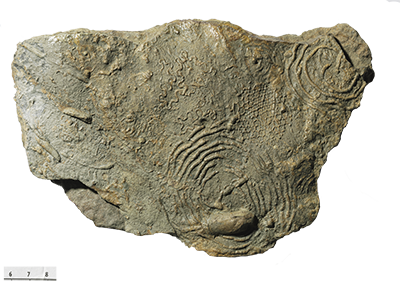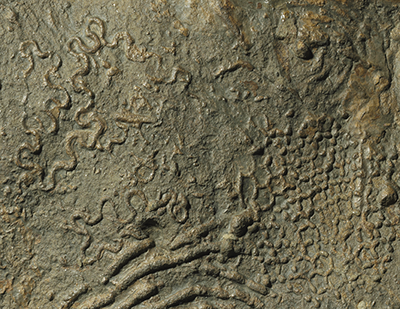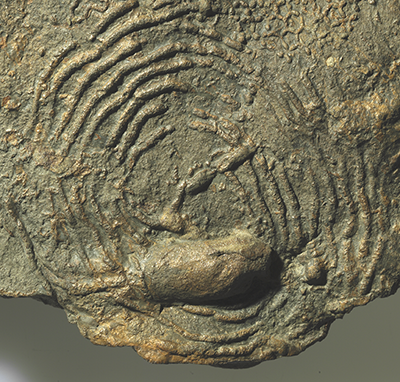Februar 2024: Graphoglyptid trace
Cenozoic: Lower Eocene, approximately 55 million years old, Gablitz, Lower Austria
Trace fossils (also ichnofossils) are the fossilized traces of living things. The branch of palaeontology that deals with trace fossils is called palichnology (from the ancient Greek palaios “old”, íchnos “footprint” and logos “teaching”). Unlike the organisms that produce them, trace fossils are classified according to their (probable) behaviour. There are, among other things, traces of rest, movement or crawling, grazing, feeding, habitation, traps, cultivation, predation, escape and breeding structures. Since different creatures can produce similar tracks and vice versa, it is often difficult to assign tracks to a unique producer. Due to different lifestyles and habits, trace associations often show a so-called storey structure, i.e. a horizontal sequence within the sediment.
Trace fossils are known from all parts of the world and date back to the Precambrian. The sandstone slab exhibited here comes from Eocene flysch sediments in Lower Austria, which were deposited under deep water conditions. The plate shows a number of different traces of life. These include comparatively large, round, spirally arranged structures (Spirorhaphe), a smaller, wavy spiral structure (Cosmorhaphe) and a structure consisting of several hexagons arranged in a row, which is strongly reminiscent of the structure of honeycombs (Paleodictyon). What they all have in common is the horizontal structure without any noticeable vertical zoning. These primarily horizontally arranged trace fossils found in flysch are also known as graphoglyptids.
Spirorhaphe and Cosmorhaphe consist of individual lines that are not or only slightly connected to each other. They probably represent feeding tracks, the aim of which is to efficiently graze as large a surface as possible. Paleodictyon, on the other hand, is a net-like trace that has been interpreted as a cultivation trace. The producing organisms could have created the burrows to breed microorganisms (bacteria, fungi, etc.). It has also been speculated that Paleodictyon could not have been created by a single animal, as the total length of the tunnel would far exceed the size range of one animal if it traversed all routes. This would suggest a higher form of organization of the producing animal species.
Thomas A. Neubauer, Munich






